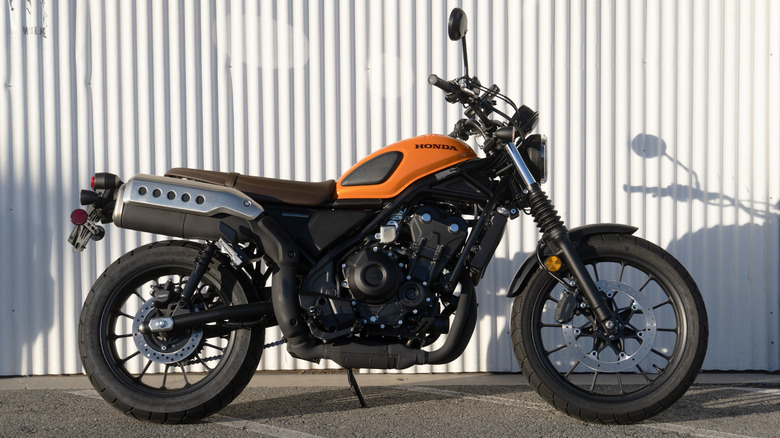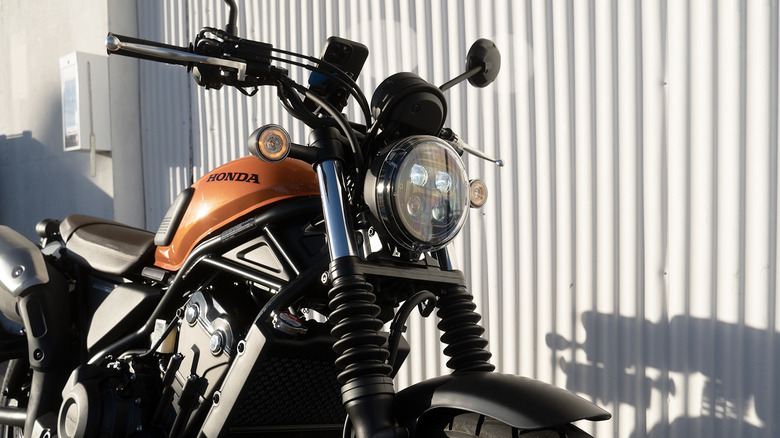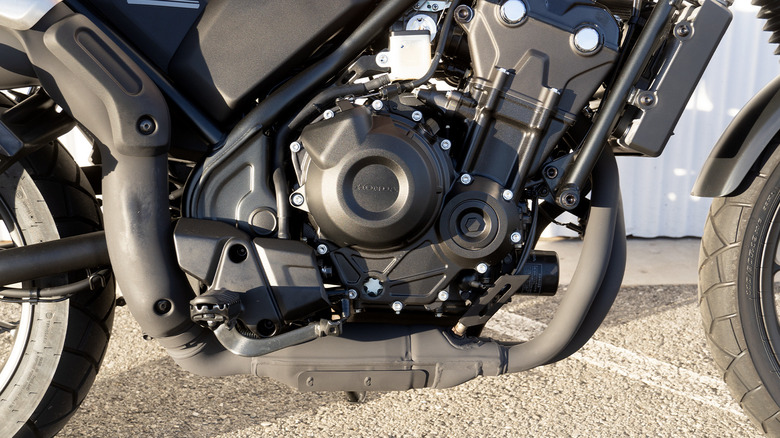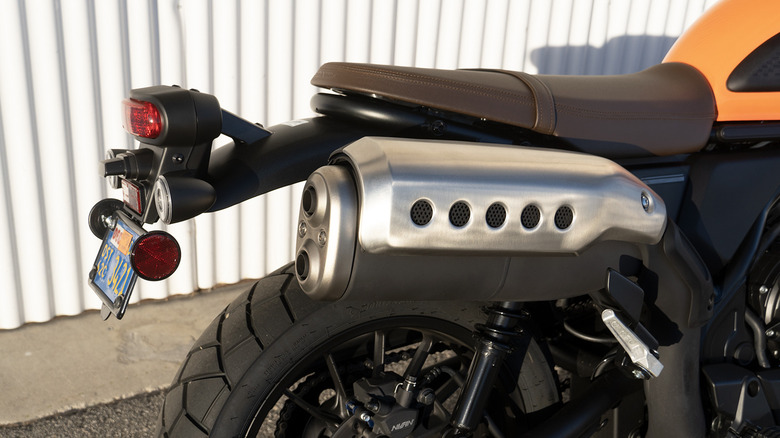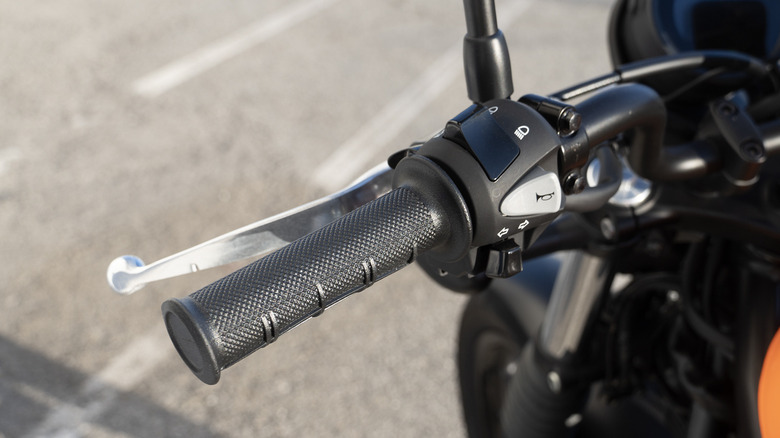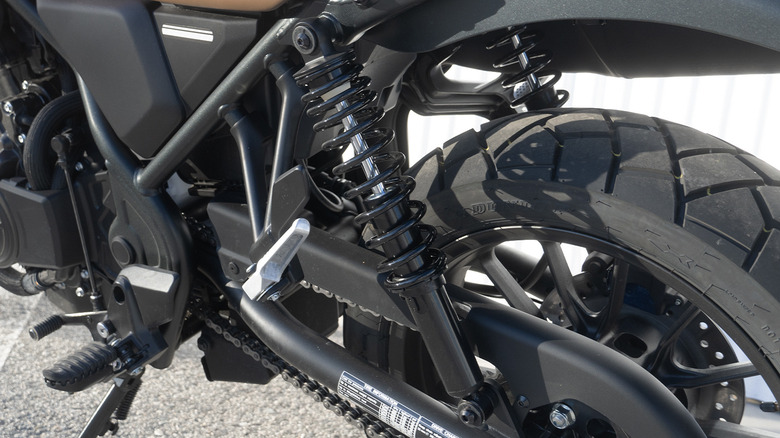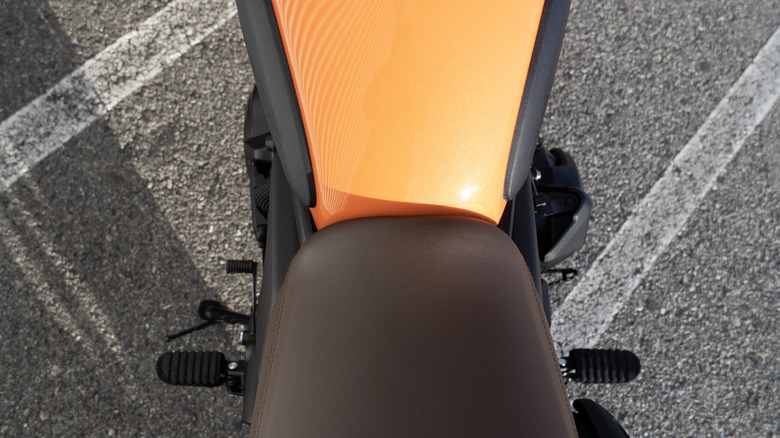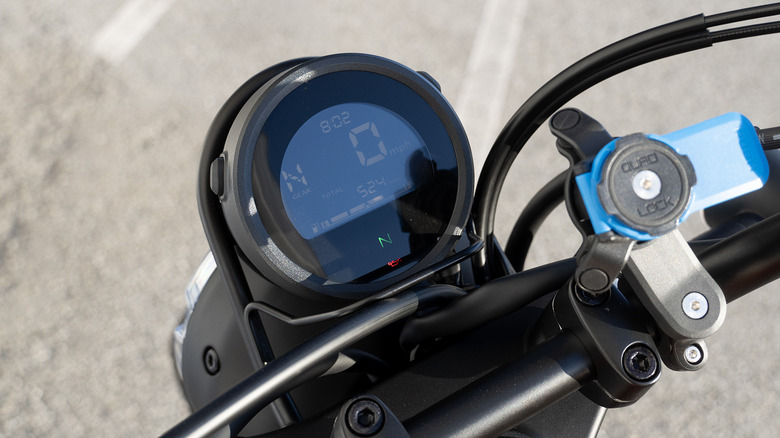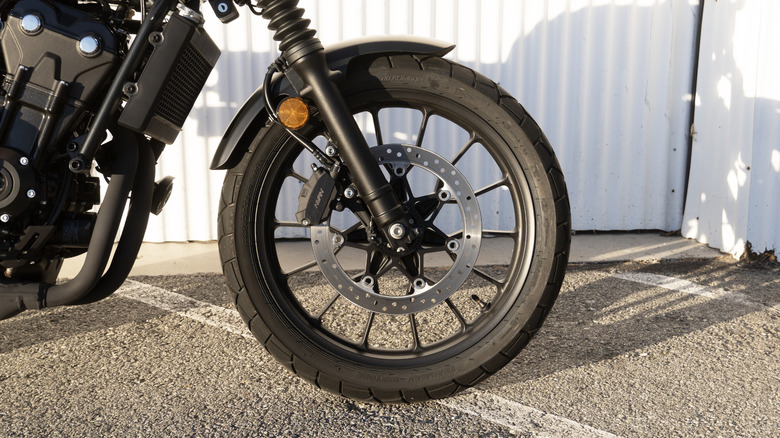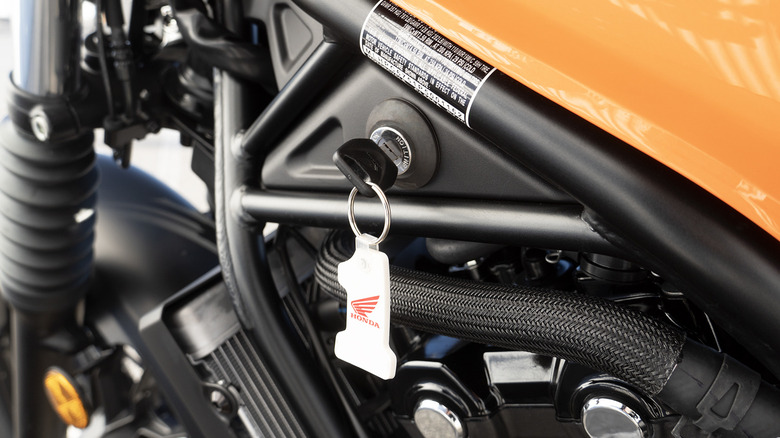2023 Honda SCL500 Review: Top Speed & HP Aren't What Make This Scrambler Bike Special
Last year, Honda announced the revival of the Scrambler in the United States and foreign markets at the same time. The bikes debuted as 2023 model years and foreign markets received the CL500, using nomenclature that harkens back to the iconic CL72s and CL77s of the 1960s, as well as CL350s and CL360s of the 1970s. But here in the US, the new Scrambler will be known as the SCL500—and in fact, Honda can only call it a "Scrambler-style" motorcycle, presumably because Ducati owns the official Scrambler name.
Regardless of alphanumerical designation, however, the foreign and domestic Scramblers all use many parts shared with the rest of Honda's lineup. A 471cc parallel twin motor carries over from the Rebel, CBR500R, and CB500X, while higher exhaust routing increases ground clearance in classic fashion, along with a larger front wheel, retro rear dampers, and front fork bellows.
Following the success of Ducati's entry-level Scrambler, as well as Triumph's Scrambler 1200, Honda now enters the game at a lower price point with a starting sticker of $6,799 (plus freight). The move seems to bank on the fact that most modern Scramblers, regardless of brand, look relatively similar from more than 15 feet away, so a cheaper alternative that still delivers all the familiar Honda quality should, therefore, attract more entry-level motorcycle buyers interested in that Scrambler style.
A quick trip back in time
Honda arguably inaugurated the Scrambler era in 1962 with the CL72 that shared just about everything with the CB72, including a four-stroke 250cc twin that revved to 9,000 RPM—nothing less than sky-high for the period. The higher exhaust routing, larger wheels, higher handlebars, and fenders all served a purpose back then, too, as Honda sent Dave Ekins and Bill Robertson Jr to ride down through Baja California in a PR stunt. That effort effectively paved the way for the Baja 1000 as we know it, even if today's Scramblers have transformed into more of an exercise in retro-urban commuters to go with technical pants and tactical leather jackets.
Honda's SCL500 delivers that aesthetic aplenty, with a leather bench seat, brushed aluminum for the exhaust cover, and almost knobby tires. The gas tank, borrowed from the Rebel but mounted flatter than on that dedicated cruiser, comes in either orange or green—of course, Honda gave out the iridescent orange for this press loaner to pop in photos.
Climb aboard the urban Scrambler
I picked up the Scrambler at Honda's headquarters in Torrance, CA, in exchange for the most hardcore motorcycle I've ever ridden: the CBR1000RR-R Fireblade that turns every road into a track. Where I found the Fireblade almost impossible to ride comfortably at 6'1" tall with long limbs, the Scrambler's upright geometry helped my wrists and knees relax noticeably. A 31.1-inch seat height makes the bike easy to flat-foot, and the bike is lightweight thanks to the small parallel twin that, in complete opposition to the Fireblade, makes somewhere in the tame mid-40 horsepower range.
Pulling away for the first time, I figured that Honda either retuned the engine or played with gear ratios for the Scrambler, because each twist of throttle brought on peppier acceleration than in the similarly equipped CB500X I rode earlier this year. A look at the spec sheet revealed that's not the case, though, so I dove deeper and now believe the difference comes down to the Scrambler weighing about 5% less than the CB500X, at 419 pounds wet versus 439, and also lacking some of the aerodynamic drag without a windscreen and even more upright riding posture.
Hitting top speed almost immediately
On the ride back up to West LA, I walked away from traffic at stoplights with ease and found that mid-level speed arrived quite quickly. We're a long way from the Fireblade, to be certain, but hauling my 170 pounds around never strained the Scrambler on city streets, where it felt happiest tooling around in third and fourth gear between 35 and 55 miles an hour. The little twin just putters smoothly enough without too much chop, and the exhaust routing never gets too loud nor too hot.
Up past about 75 miles an hour in fifth or sixth gear, though, those 471 cubic centimeters reach the edge of potential performance. The bike will get up to a few miles per hour past 80 on flat ground, possibly more happily than the CB500X, but reverberations through the frame start a tinny and buzzy sensation in the seat and handlebars. On the way up to that top speed, though, the Scrambler delivers everything to love about Honda's expanding motorbike lineup.
Simply pleasing, in almost every way
Rolling into the Scrambler's throttle almost never produces any lurching, with progressive power but no touchiness unless I completely let off and the combination of aero drag and suspension travel caused a bit of nose dive. The helpful addition of a slipper/assist clutch likely improves any stop-start sensitivity, but also makes the clutch lever itself perfectly lightweight to keep hands from tiring during the daily commute.
Positive shift pedal engagement never left me in doubt whether I had engaged the next gear up or down, and even the turn signal switchgear on the left grip switched on and off with a satisfactory little click (much better than the Fireblade's, in fact, despite the fractional pricing). Pulling the into brake lever, meanwhile, causes that bit of nose dive, too, even if the single front disc with Nissin two-piston caliper never feels particularly bitey. My Scrambler came equipped with ABS, though I never gave a strong enough yank into the brakes to find that mesh point.
Reminders of a bygone era
Once upon a time, I thought I needed a 1976 Honda CB360T (be honest, who hasn't felt the lust for a 70s CB at one time or other?). That urge passed by (for the most part, anyway) without me ever making a purchase, but I test rode a couple of potentials two summers ago and in certain regards, the new SCL500 reminded me of those bikes. The suspension, with the retro bellows on the front forks and dual rear coilovers, definitely approaches a similar level of stable compliance. And a little twin with sewing machine smoothness also fits perfectly into the appeal and classic aura.
Soft enough for comfortable cruising and able to absorb speed bumps without completely wallowing up or down, the SCL500's factory setup seems just right in comparison to those older CBs—somewhat lighter and taller than the more compact older bikes, but the spirit shining through regardless. Five-position adjustable spring preload at the rear means heavier or lighter riders can tweak a bit if they feel so inclined, and doing so might amp up the either the sportier or off-roady personality of this new Scrambler, which can get into some mild canyon carving happily.
Cute face, slim waist, and a big clutch cover
But sliding over and hanging off the bench seat isn't really the point here, though, given the high bars and foot pegs mounted relatively far forward (even if a bit higher than expected). When asked to lean over and hustle through curves, the overall weight and 19-inch front wheel create a nimble, almost tossable, nature to the SCL500 nonetheless. Here the smooth throttle response and simple brakes make transitioning between bends and straights a blast, even if the true pace won't launch speed freaks out of the water.
Perhaps most surprisingly, the SCL500 also offers slightly more suspension travel than the CB500X, a more dedicated ADV bike. That counterintuitive fact might harken back to the original Scramblers' off-road provenance, but the bike I rode felt more perfectly engineered for city commuting than Baja adventuring. Just check out the exhaust routing, which on the modern version does travel at the very bottom of the frame unlike on early Scramblers. Honda needed to make room for the water-cooling system, to be fair, but banging the exhaust off rocks makes anything more than graded dirt roads something of a problem for the new bike.
Water cooling and the slipper clutch probably explain the extremely asymmetric spacing of the engine and clutch covers best. In this case, the clutch cover sticks out multiple inches further on the right of the frame, which made weight shifts in the canyons odd when my calves brushed up against the metal, but also requires a peculiar bow-legged stance at stoplights. At least the clutch cover never got too terribly hot, though.
Keep it simple silly
Compared to all the various adjustable settings on the Fireblade, ranging from throttle response and engine braking to shock damper firmness and traction control intervention, riding the Scrambler delivered a breath of fresh simple air. A small circular gauge screen displays only time, speed, gear selection, odometer count, and fuel remaining. No RPM tachometer and no coolant temp, though this ubiquitous parallel twin will probably run forever regardless of how just about any rider treats it.
Some of Honda's budgetary considerations start to show upon closer examination, though. The gauge screen's tinting and lighting often make actually reading the display somewhat difficult, in glare or direct sunlight and especially with a tinted helmet visor. And other details up close also stand out, from the cheaper exhaust metal with brushed aluminum cover that resembles kitchenware, to textured plastic thigh grips on the gas tank. Locating the ignition key to the left and below the gas tank, with the handlebar locking switch below the forks, also requires a bit of an adjustment getting off the non-stop stream of range-topping exotics I typically ride.
The budget Scrambler
Maybe those details make the SCL500 more appealing, in a way, though the affordable price required to play also probably leaves some buyers with the budget to start a bit of customization. Honda knows custom goodies will fit into the new Scrambler's charm, and offers everything from hand guards to front fenders to further accentuate any potential off-road cred.
Of course, I'd start with the Matte Laurel Green Metallic tank rather than Candy Orange, but a tail tidy first thing and aftermarket exhaust to open up the parallel twin would definitely be on my list. Maybe a set of lower handlebars to accentuate a cafe racer look (yes, I know, that's not particularly in the vein of Baja riding, but taste is subjective after all). And real knobby tires in place of the Dunlop Trailmax Mixtours would go a long way towards helping the SCL500 look more legit among its competitors, too.
Comps among competitors
That Scrambler market keeps expanding, though. After Honda announced the SCL500 (and CL500), Triumph revealed a new Scrambler 400 X for 2024, as well, that runs even lower on the pricing scale with a sticker of only $5,595. The Triumph looks, to my eye, just a smidge better than the Honda, but the upright riding position and lack of fairings means that where Honda's 471cc parallel twin feels almost on the edge of being slow, about 15% less power from Triumph's entry-level Scrambler probably won't sound great for anyone who plans to do any real highway or freeway riding.
Ducati, meanwhile, elevated their Scrambler for 2024 with a new generation of the Full Throttle variant that cuts weight by 8.8 pounds versus the previous year, while an air-cooled L-twin puts out 73 horsepower. With more features including a standard quickshifter and Termignoni exhaust, plus stylistic revisions like lower bars and a sump skid guard, the Full Throttle is definitely the nicer bike—but also costs almost double the Honda SCL500 at $12,195. Funnily enough, I received the Ducati Scrambler Full Throttle as a loaner the same day I gave Honda back the SCL500, so stay tuned for more thorough impressions coming soon.
In the context of the Triumph and Ducati Scramblers, the retro vibe that I thought clashed with Honda's more modern headlight cluster probably nails the combo aesthetic that urban buyers want—turns out maybe market research is a thing. And that market research likely shows that in almost every regard, from the pricing to the style and performance, the SCL500's entry into the modern Scrambler market treads a perfect middle ground for new and experienced riders alike.
